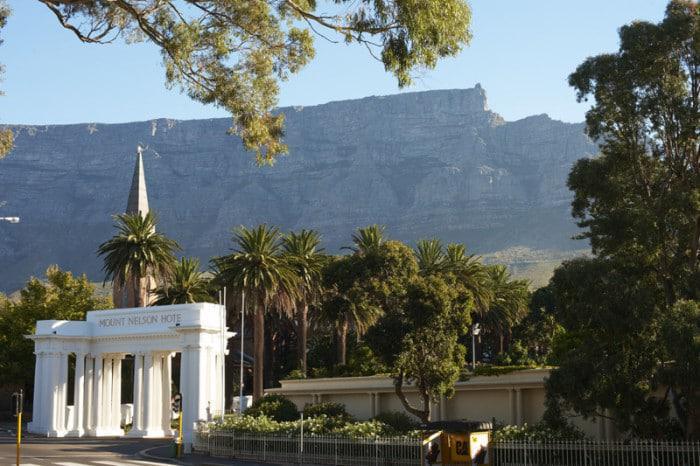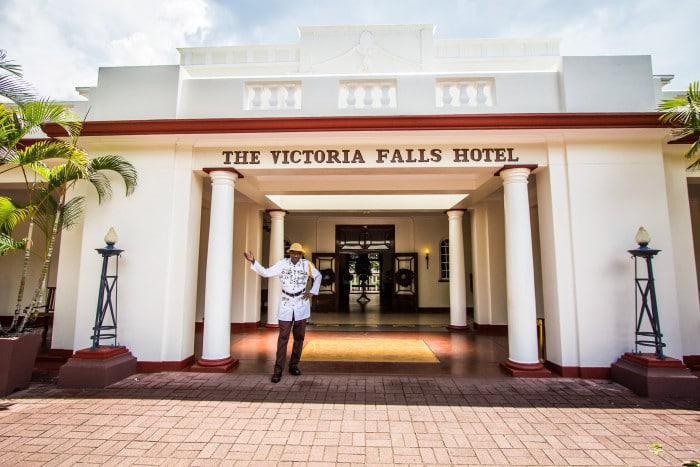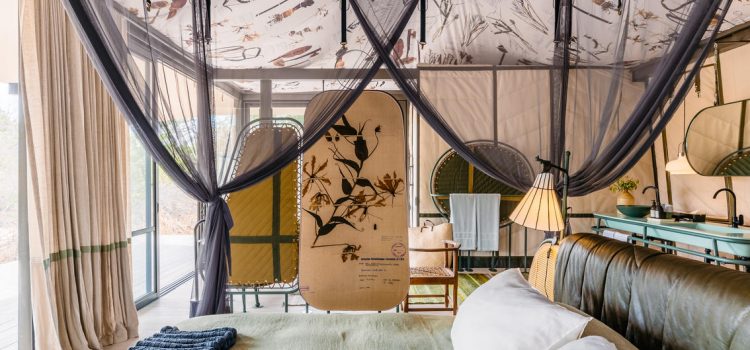For over 300 years, Africa has held a special fascination for travelers and fortune seekers alike. Although some travelers prefer to stay in the latest ultra chic, modern hotels there is a certain magic that is only to be found in a hotel steeped in history.
We have rounded up our best-loved and most treasured historic hotels in which you can immerse yourself in old world ambiance, learn more about the history of Southern Africa and discover the charms of a bygone era.
1. Oude Werf Hotel
Located in a pretty oak-lined avenue in the charming old town of Stellenbosch, The Oude Werf Hotel is one of the historic secrets of the Cape Winelands, transporting visitors back to a bygone era of romantic four-poster beds and priceless antiques.
In 1686, the Reverend Johannes Overneij and Governor Simon van der Stel established the colony’s first church in the early days of the Stellenbosch settlement. Until that point in time, church services had either been held aboard ships moored in Table Bay or at the Castle in Cape Town. The new house of worship was constructed out of the materials of the day: local clay, stone and rough plaster with a lime-coated finish, yellowwood floor boards and beams, a simple gable, and a thatched roof.
Sadly a fire devastated much of the church in December 1710, and for many years the churchyard stood deserted until the land was divided into plots.
1802 saw the Wium family opening a ‘herberg’ (inn) on this ground which is now the location of South Africa’s oldest hotel. If you peek beneath the floorboards of the kitchen, you can still see the remains of the church.
In December 1803, a second fire ripped through the town destroying 42 homes including the Oude Werf.
A new Cape Dutch inn was built, complete with a front gable and steeply pitched thatched roof, which unfortunately also succumbed to a third fire in the 1890’s. The façade was again restored, this time with vaguely Georgian lines. To this day, charred door and window frames can still be seen in the central lounge.
For visitors seeking an authentic Cape Winelands experience which cleverly blends the town’s old history with the modern energy of a bustling University town, the Oude Werf Hotel is pure bliss.

2. Mount Nelson Hotel
The Mount Nelson Hotel or ‘The Nellie’ as it’s affectionately called by locals is the grand old matriarch when it comes to South African historic hotels. Legendary for its afternoon High Tea, wartime legends and pink exterior, the hotel first opened its doors on the 6th of March 1899. The most recent purchase of shipping magnate Sir Donald Currie, owner of the Union-Castle Shipping Line, the Mount Nelson Hotel opened just eight months prior to the first shots being fired in the Anglo-Boer War.
The hotel was built to rival any in London and was especially popular with wealthy visitors escaping the muddy diamond mines of Kimberley and the dusty goldfields of the Transvaal. It was also the first hotel that offered guests both hot and cold running water.
With the start of the Boer War in 1899, the Mount Nelson was used as the British military’s headquarters. During this time Lord Kitchener, Lord Roberts and Sir Redverse Buller visited, as well as a youthful war correspondent called Winston Churchill who described it as ‘a most excellent and well appointed establishment which may be thoroughly appreciated after a long sea voyage’!
When the First World War ended in 1918, the Mount Nelson commemorated this momentous occasion by painting its exterior pink. The hotel was also declared a ‘plague-free zone’ by the city’s medical doctors in 1919, as the deadly flu virus ravaged Cape Town.
The Prince of Wales visited in 1925 and to honour his visit the iconic palm-lined driveway and ‘Prince of Whales Gate’ were added to the hotel. If you peek into one of the Garden Rooms, you will be able to see the original wooden chairs that were once the deck chairs used on the Union-Castle Line ships.
Over the years, this historic building has seen many changes such as additional rooms and the first ever heated swimming pool in Africa! One thing has remained constant throughout, the elegance, location and sheer luxury that you feel when staying at this glorious hotel.

3. Cape Heritage Hotel
If you’re looking for a boutique hotel set right in the heart of historic 18th century Cape Town, then the Cape Heritage Hotel is the perfect option for you.
Located in the restored Heritage Square surrounded by famous Cape Town streets such as Buitengracht, Bree and Shortmarket Street, the Cape Heritage Hotel was built in the early 1780’s.
Like most buildings of the time, the hotel is built around a central courtyard where the oldest fruit-bearing grapevine (planted in 1781) still thrives to this day. The original building was used for commercial purposes and housed amongst others bakers, gunsmiths, coach makers, as well as a chapel, undertaker and boarding house.
In the 1960’s this historical square was nearly demolished, as the city planned to build a multi-storey car park in its place. Luckily this project was cancelled due to financial difficulties. Instead towards the end of the 1980’s, the city of Cape Town decided to restore the square in the biggest private conservation project Cape Town had ever seen.
The Cape Heritage Hotel is ideal for anyone wanting to immerse themselves in South Africa’s rich historical and cultural heritage, ideally located in the city centre, and within walking distance of many prime Cape Town attractions. It is also within easy walking distance of Bree Street with it’s trendy specialty shops and cafés.

4. Vineyard Hotel
Tucked up under the mountain in the southern suburbs of Cape Town lies a hotel that needs little introduction. The Vineyard Hotel is an old Cape Town favourite and one of this city’s finest hotels.
Originally purchased in 1799 as a country house for Lady Anne and Andrew Barnard, this magnificent property went through the hands of numerous owners before Mr William Billingsley (a wealthy merchant) bought it in 1844 and transformed the quaint thatched home into a double storey.
James Mitchell, a Scottish banker, then bought the property in 1894 as an investment and decided to turn it into a hotel. For almost a century, the property went through numerous owners, but in 1980, The Vineyard Hotel was born when the Petousis family bought it. Francois Petousis (a Swiss-trained hotelier who developed the Criterion Hotel in Johannesburg and The Townhouse Hotel in Cape Town) immediately saw the immense potential of the old hotel and demolished all 60 existing rooms.
Today The Vineyard is a luxurious establishment set in beautiful gardens (including a small vineyard) at the foot of the forested slopes of Table Mountain with 175 rooms, two restaurants, an award-winning Conference Centre and a superb Spa.
Famous for documenting life in the Cape in the 18th century, Lady Anne Barnard’s open-minded and observant personality and her legacy is celebrated in many aspects of the hotel.

5. The Cellars-Hohenhort Hotel
Cape Town has a rich and fascinating history, and the story behind The Cellars-Hohenhort Hotel is no different.
The Cape became a settlement in 1652 out of the need to create a refreshment station to replenish the Dutch East India Company sailors after their long and arduous journey from Europe on their way to Asia to purchase spices.
The original sweeping estate on which The Cellars-Hohenort now stands was originally known as Klaasenbosch Farm and was bought in 1693 by the Dutch East India’s chief surgeon, Hendrik ten Damme. This part of Cape Town has incredibly fertile soil, perched on the eastern face of Table Mountain and the farm quickly became a part of the thriving wine industry of Constantia, as this area is known today. The actual Cellars building was, in fact, the original Klaasenbosch wine cellar.
In 1906, the farm was bought by Arnold Spilhaus, who started construction of the Hohenort building and replaced the original thatched farmhouse with a German styled manor. Following his death in 1947, the farm was divided and sold off.
Interestingly enough, it was also in these very gardens that a former owner of the Cellars, Mr Fischer, hybridized the ‘Chris Barnard’ rose, named after South Africa’s most famous heart surgeon.
In 1991, celebrated hotelier, Liz McGrath, (who also established the The Plettenberg) acquired the Cellars building with the aim to restore the country manor to its former historical glory. The original roof timber was used in building the Cellar’s Oregon pine staircase, whilst the lounge still makes use of the original beam structure.
The hotel saw a full refurbishment and was selected to become part of the world renowned Relais & Châteaux family of hotels. McGrath bought the hotel in February 1993, and after extensive renovations the two properties and their surrounding nine acres of land were finally united again.

6. The Lord Milner Hotel
Set in the heart of the Western Cape Karoo in the quaint village of Matjiesfontein, The Lord Milner Hotel, is over 120 years old. Famed for its dry, crisp Karoo air (not dissimilar to a glass of dry champagne apparently!) this is a must-stop destination en route between Johannesburg and Cape Town. The luxurious Blue Train and Rovos Rail still stop in Matjiesfontein so that passengers can stretch their legs and snoop around the historic town and its hotel.
The Lord Milner officially opened its doors in November 1889 as a fashionable Victorian spa and attracted many of the celebrities and politicians of the day. During the 1890’s Matjiesfontein was visited by a steady stream of well-known personalities such as Cecil John Rhodes, Rudyard Kipling, Lord Randolph Churchill (Winston’s father), the Duke of Hamilton and the Sultan of Zanzibar.
James Logan (the founder of Matjiesfontein) built the double story Milner Hotel in 1899, just as the Anglo-Boer War was breaking out. He died in 1920 and his tomb can be found about 10km outside of Matjiesfontein next to the grave of one of the greatest English cricketers, George Lohman, who chose to spend his twilight years in the wonderful climatic environment of the Karoo.
During the Anglo-Boer War, the Milner Hotel became the Cape Command’s headquarters with the turret being used as a machine gun post and lookout platform. Later, it housed the military hospital for wounded British troops.
David Rawdon, whose claim to fame includes establishing the Lanzerac Hotel in Stellenbosch and the Marine Hotel in Hermanus, bought Matjiesfontein Village, completely renovated and renamed the hotel The Lord Milner Hotel in 1970 after Lord Alfred Milner (the governor of the Cape during the Boer War).
Perfect for the history buffs and anyone seeking a Victorian setting filled with period antiques, bygones and museums set in the middle of the breathtaking Karoo.

7. The Victoria Falls Hotel
Located in Zimbabwe, overlooking one of The Seven Natural Wonders of the World, The Victoria Falls Hotel is straight out of an Edwardian novel with its imposing architecture and old school atmosphere.
Built in the early 1900’s, the hotel had its grand opening in 1904 to house passengers of the newly built railway, part of the Cecil Rhodes plan to famously link Cape Town to Cairo. The hotel itself is set in beautifully maintained gardens with lily pads and century-old trees, located a mere 10 minutes stroll away from a private footpath which features spectacular views over the thundering Victoria Falls.
Some years on, the Victoria Falls Hotel was also the staging post for the BOAC flying boat service between South Africa and Southampton, and this grand colonial hotel even attracted royalty in 1947 when King George VI visited with his family.
Enjoy the true grandeur of this magnificent hotel and immerse yourself in the age-old tradition of enjoying a freshly brewed cup of Earl Grey tea and oven baked scones during afternoon tea, served daily at Stanley’s Terrace with sweeping views over the Victoria Falls Bridge which links Zimbabwe to Zambia.




